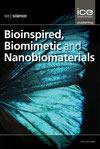基于羧甲基壳聚糖/明胶/羟基磷灰石的骨组织工程仿生冷冻材料
IF 0.6
4区 工程技术
Q4 ENGINEERING, BIOMEDICAL
引用次数: 0
摘要
在低于溶剂冰点的温度下进行的凝胶化被称为冷冻凝胶化,由于其机械和结构性能的改善,在再生医学中引起了关注。本研究的重点是使用冷冻凝胶作为一种通用的方法来制备仿生支架,该支架具有提高的机械强度和更大的孔径,具有骨组织工程应用的潜力。这些包含羧甲基壳聚糖/明胶/纳米羟基磷灰石的支架是通过冷冻凝胶形成的。研究了交联剂浓度、矿物含量和明胶与聚合物的比例三个参数对其物理、化学和力学性能的影响。在这项工作中,MG63细胞被用于体外测定。此外,还进行了体内实验来研究纳米复合支架的生物相容性。结果表明,所有支架都具有多孔结构,孔隙相互连接,形态与骨结构相似。它们的孔径、孔隙率和溶胀率随着交联剂浓度的增加而降低,而纳米羟基磷灰石则具有相反的作用。XRD结果还表明,无机相在基体中保持了结晶度,晶体尺寸略有减小。此外,该支架在体外或体内研究中均未显示毒性。结果表明,基于羧甲基壳聚糖/明胶/羟基磷灰石的仿生冷冻凝胶具有骨组织工程的潜力。本文章由计算机程序翻译,如有差异,请以英文原文为准。
Biomimetic cryogels based on carboxymethyl chitosan/gelatin/hydroxyapatite for bone tissue engineering
Gelation at temperature below freezing point of solvent is known as cryogelation that attracted attention in regenerative medicine due to improved mechanical and structural properties. This study focuses on using cryogelation as a versatile method for fabricating biomimetic scaffolds with improved mechanical strength and larger pore size with potential for bone tissue engineering applications. These scaffolds comprising carboxymethyl-chitosan/gelatin/ nano-hydroxyapatite were formed via cryogelation. The effects of three parameters, including crosslinker concentration, mineral content and gelatin-to-polymer ratio, were investigated on the physical, chemical and mechanical properties. In this work, MG63 cells were used for in vitro assay. In addition, in vivo assay was conducted to investigate the biocompatibility of nanocomposite scaffolds. The results showed that all scaffolds have a porous structure with interconnected pores with morphology similar to bone structure. Their pore size, porosity, and swelling ratio decreased with increased crosslinker concentration, while nano-hydroxyapatite has the opposite effect. XRD results also showed that the inorganic phase retained its crystallinity in the substrate with a slight decrease in crystal size. In addition, the scaffold showed no toxicity in either in vitro or in vivo studies. Obtained results showed that the biomimetic cryogels based on carboxymerthyl chitosan/gelatin/hydroxyapatite has a potential for bone tissue engineering.
求助全文
通过发布文献求助,成功后即可免费获取论文全文。
去求助
来源期刊

Bioinspired Biomimetic and Nanobiomaterials
ENGINEERING, BIOMEDICAL-MATERIALS SCIENCE, BIOMATERIALS
CiteScore
2.20
自引率
0.00%
发文量
12
期刊介绍:
Bioinspired, biomimetic and nanobiomaterials are emerging as the most promising area of research within the area of biological materials science and engineering. The technological significance of this area is immense for applications as diverse as tissue engineering and drug delivery biosystems to biomimicked sensors and optical devices.
Bioinspired, Biomimetic and Nanobiomaterials provides a unique scholarly forum for discussion and reporting of structure sensitive functional properties of nature inspired materials.
 求助内容:
求助内容: 应助结果提醒方式:
应助结果提醒方式:


